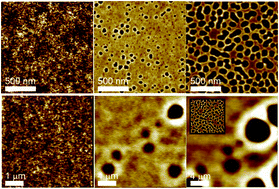Nucleated dewetting in supported ultra-thin liquid films with hydrodynamic slip†
Abstract
This study reveals the influence of the surface energy and solid/liquid boundary condition on the breakup mechanism of dewetting ultra-thin polymer films. Using silane self-assembled monolayers, SiO2 substrates are rendered hydrophobic and provide a strong slip rather than a no-slip solid/liquid boundary condition. On undergoing these changes, the thin-film breakup morphology changes dramatically – from a spinodal mechanism to a breakup which is governed by nucleation and growth. The experiments reveal a dependence of the hole density on film thickness and temperature. The combination of lowered surface energy and hydrodynamic slip brings the studied system closer to the conditions encountered in bursting unsupported films. As for unsupported polymer films, a critical nucleus size is inferred from a free energy model. This critical nucleus size is supported by the film breakup observed in the experiments using high speed in situ atomic force microscopy.



 Please wait while we load your content...
Please wait while we load your content...